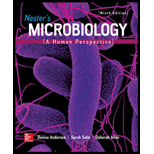
Concept explainers
How is immune globulin different from hyperimmune globulin?
To review:
The difference between immune globulin and hyperimmune globulin.
Introduction:
The antibody, which is also called immunoglobulin, is glycoprotein having Y-shape structure. Immunoglobulin plays a very important role in immunization of an organism. Structure of antibody hastwo heavy along with two light chains in it. Antibodies are used by the immune system of the body to kill the specific pathogens, which enter in the body and helps in providing immunity to an individual. Antibody contains epitope thatacts as antigen binding site and recognizes the specific antigen.
Explanation of Solution
The difference between immune globulin and hyperimmune globulin are given in the table below:
| Immune globulin | Hyperimmune globulin |
| Immune globin is the IgG fraction or solution obtained from the blood plasma of many donors. Immune globulin contains various types of antibodies in it due to the variety of infections and typical medications and vaccination experienced by the donors. | Hyperimmune globulin is prepared or obtained from the serum of individuals having specific and increased amount of antibodies to certain diseases. |
| Immune globulin is used to cure or treat a variety of infections because it contains various type of antibodies in it. | Hyperimmune globulin is used to treat specific infections and diseases because the antibodies present in hyperimmune globulin are very specific for the specific type of antigen. These are reactive for a particular type of antigens. |
| For example, hepatitis A and measles can be cure by administrating the immune globulin in the unvaccinated people having a lower number of antibodies. | For example, protection against hepatitis B, rabies and tetanus can be provided by preparing HBIG (hepatitis B immune globulin), RIG (rabies immune globulin) and TIG (tetanus immune globulin). |
Thus, it can be concluded that immune globulin contains various types of antibodies and is obtained from the blood plasma of individual and is not specific for an antigen while hyperimmune globulin is very specific in function.
Want to see more full solutions like this?
Chapter 18 Solutions
Nester's Microbiology: A Human Perspective
- can you help? I think its B but not surearrow_forwardSkip to main content close Homework Help is Here – Start Your Trial Now! arrow_forward search SEARCH ASK Human Anatomy & Physiology (11th Edition)BUY Human Anatomy & Physiology (11th Edition) 11th Edition ISBN: 9780134580999 Author: Elaine N. Marieb, Katja N. Hoehn Publisher: PEARSON 1 The Human Body: An Orientation expand_moreChapter 1 : The Human Body: An Orientation Chapter Questions expand_moreSection: Chapter Questions Problem 1RQ: The correct sequence of levels forming the structural hierarchy is A. (a) organ, organ system,... format_list_bulletedProblem 1RQ: The correct sequence of levels forming the structural hierarchy is A. (a) organ, organ system,... See similar textbooks Bartleby Related Questions Icon Related questions Bartleby Expand Icon bartleby Concept explainers bartleby Question Draw a replication bubble with two replication forks.blue lines are DNA single strands and red lines are RNA single strands.indicate all 3' and 5’ ends on all DNA single…arrow_forwardProvide an answerarrow_forward
- Question 4 1 pts Which of the following would be most helpful for demonstrating alternative splicing for a new organism? ○ its proteome and its transcriptome only its transcriptome only its genome its proteome and its genomearrow_forwardIf the metabolic scenario stated with 100 mM of a sucrose solution, how much ATP would be made then during fermentation?arrow_forwardWhat is agricuarrow_forward
- When using the concept of "a calorie in is equal to a calorie out" how important is the quality of the calories?arrow_forwardWhat did the Cre-lox system used in the Kikuchi et al. 2010 heart regeneration experiment allow researchers to investigate? What was the purpose of the cmlc2 promoter? What is CreER and why was it used in this experiment? If constitutively active Cre was driven by the cmlc2 promoter, rather than an inducible CreER system, what color would you expect new cardiomyocytes in the regenerated area to be no matter what? Why?arrow_forwardWhat kind of organ size regulation is occurring when you graft multiple organs into a mouse and the graft weight stays the same?arrow_forward
- What is the concept "calories consumed must equal calories burned" in regrads to nutrition?arrow_forwardYou intend to insert patched dominant negative DNA into the left half of the neural tube of a chick. 1) Which side of the neural tube would you put the positive electrode to ensure that the DNA ends up on the left side? 2) What would be the internal (within the embryo) control for this experiment? 3) How can you be sure that the electroporation method itself is not impacting the embryo? 4) What would you do to ensure that the electroporation is working? How can you tell?arrow_forwardDescribe a method to document the diffusion path and gradient of Sonic Hedgehog through the chicken embryo. If modifying the protein, what is one thing you have to consider in regards to maintaining the protein’s function?arrow_forward
 Human Biology (MindTap Course List)BiologyISBN:9781305112100Author:Cecie Starr, Beverly McMillanPublisher:Cengage Learning
Human Biology (MindTap Course List)BiologyISBN:9781305112100Author:Cecie Starr, Beverly McMillanPublisher:Cengage Learning Biology (MindTap Course List)BiologyISBN:9781337392938Author:Eldra Solomon, Charles Martin, Diana W. Martin, Linda R. BergPublisher:Cengage Learning
Biology (MindTap Course List)BiologyISBN:9781337392938Author:Eldra Solomon, Charles Martin, Diana W. Martin, Linda R. BergPublisher:Cengage Learning Concepts of BiologyBiologyISBN:9781938168116Author:Samantha Fowler, Rebecca Roush, James WisePublisher:OpenStax College
Concepts of BiologyBiologyISBN:9781938168116Author:Samantha Fowler, Rebecca Roush, James WisePublisher:OpenStax College Biology: The Dynamic Science (MindTap Course List)BiologyISBN:9781305389892Author:Peter J. Russell, Paul E. Hertz, Beverly McMillanPublisher:Cengage Learning
Biology: The Dynamic Science (MindTap Course List)BiologyISBN:9781305389892Author:Peter J. Russell, Paul E. Hertz, Beverly McMillanPublisher:Cengage Learning





